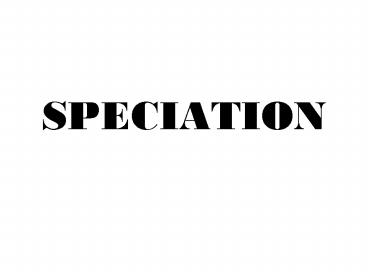SPECIATION - PowerPoint PPT Presentation
1 / 19
Title:
SPECIATION
Description:
SPECIATION * What makes a species? Organisms that can breed and create fertile offspring in nature Examples: Ducks from the same species: reproduce to make baby ducks ... – PowerPoint PPT presentation
Number of Views:330
Avg rating:3.0/5.0
Title: SPECIATION
1
SPECIATION
2
- What makes a species?
- Organisms that can breed and create fertile
offspring in nature
3
Examples
- Ducks from the same species
- reproduce to make baby ducks that can breed
- Horses and donkeys are different species
(different number of chromosomes) - A horse and a donkey make a mule that is sterile
4
- SPECIATION
- The emergence of a new species from pre-existing
species due to Natural selection and Reproductive
Isolation - What is reproductive isolation
- Anything that keeps a species from reproducing
5
Types of Reproductive isolation
- Geographic isolation
- physical separation of individuals in a species
- Ecological isolation
- two individuals live in different habitats
- Behavioral isolation
- two individuals have different mating patterns
6
- Geographic isolation
- (physical separation)
- leads to..
- Reproductive isolation
- (cant mate together anymore)
- leads to..
- Speciation
- (The two parts of the population can no longer
interbreed with each other because of genetic or
physical differences) - They are now different species!
7
- Variation in most populations results in a bell
curve
Average
Above average
Below average
8
Types of Selection
- 1- Stabilizing Selection Natural selection
pressures favor the average trait
The average trait is favored so the peak of the
curve becomes higher and narrower
This will not result in speciation
9
- 2- Directional Selection Natural selection
pressures favor one extreme or the other
In this population, the above average trait was
favored
This could result in speciationas the ones with
the average trait die out and the whole
population shifts, it will become a new species,
different from the species it once was
10
- 3- Disruptive Selection Natural selection
pressures favor both extremes
In this population, both above average and
below average traits were favored the average
trait was selected against
This will eventually lead to speciation because
the two extremes will become too different from
each other to interbreed
11
- Reproductive isolation and Speciation
- leads to more diversity of life on earth
- greater biodiversity
- Example
- Blue jays and
Stellers jays - seen east
- of Rocky Mtns.
- seen west
- of Rocky Mtns.
12
- These were most likely one species at one time, a
long time ago - When the Rocky Mountains arose 65 million years
ago, the single species became separated by the
mountain range - This happened very very slowly!!!
13
Speciation in Canada Geese
- There are 11 different races of Canada Geese
- They are currently all the same species and could
interbreed - Due to their behavior, they stay separated from
each other - They all have separate flyways and separate
breeding grounds
14
(No Transcript)
15
- Eventually, they will become different enough due
to isolation from each other that they will no
longer be considered the same species
16
Types of EvolutionGradualism Punctuated
Equilibrium
- Gradualism species originate through a gradual
change of adaptations - slow and steady change over time
- Punctuated Equilibrium speciation occurs
quickly, in rapid bursts, with long periods of
equilibrium in between - environmental changes lead to rapid changes in a
small populations gene pool that is
reproductively isolated from the main population - Speciation happens much more quickly
17
Speciation in Elephants
Fossil record supports the view that several
elephant species may have evolved from an
ancestral population in a short time
18
Adaptive Radiation
- Occurs when a species lands in a new area
- Individuals spread out into new habitats and
specialize, eventually becoming different
species - This is a type of divergent evolution
19
Honey Creepers
The founder species landed on Hawaii about 5
million years ago and settled into the diverse
Hawaiian niches































